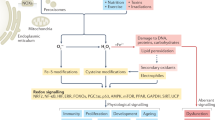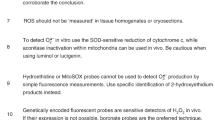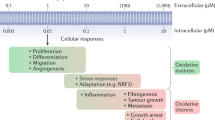Abstract
There is a vast literature on the generation and effects of reactive oxygen species in biological systems, both in relation to damage they cause and their involvement in cell regulatory and signaling pathways. The biological chemistry of different oxidants is becoming well understood, but it is often unclear how this translates into cellular mechanisms where redox changes have been demonstrated. This review addresses this gap. It examines how target selectivity and antioxidant effectiveness vary for different oxidants. Kinetic considerations of reactivity are used to assess likely targets in cells and how reactions might be influenced by restricted diffusion and compartmentalization. It also highlights areas where greater understanding is required on the fate of oxidants generated by cellular NADPH oxidases and on the identification of oxidant sensors in cell signaling.
This is a preview of subscription content, access via your institution
Access options
Subscribe to this journal
Receive 12 print issues and online access
$259.00 per year
only $21.58 per issue
Buy this article
- Purchase on SpringerLink
- Instant access to full article PDF
Prices may be subject to local taxes which are calculated during checkout




Similar content being viewed by others
References
Halliwell, B. & Gutteridge, J.M.C. Free Radicals in Biology and Medicine 1–677 (Oxford University Press, Oxford, 2007).
Heart Protection Study Collaborative Group. MRC/BHF Heart Protection Study of antioxidant vitamin supplementation in 20,536 high-risk individuals: a randomised placebo-controlled trial. Lancet 360, 23–33 (2002).
McCord, J.M. & Fridovich, I. Superoxide dismutase: an enzymic function for erythrocuprein (hemocuprein). J. Biol. Chem. 244, 6049–6055 (1969).
O'Brien, P.J. Molecular mechanisms of quinone cytotoxicity. Chem. Biol. Interact. 80, 1–41 (1991).
O'Brien, P.J. Radical formation during the peroxidase catalyzed metabolism of carcinogens and xenobiotics: the reactivity of these radicals with GSH, DNA, and unsaturated lipid. Free Radic. Biol. Med. 4, 169–183 (1988).
Winterbourn, C.C. Free radical production and oxidative reactions of hemoglobin. Environ. Health Perspect. 64, 321–330 (1985).
Nathan, C. Specificity of a third kind: reactive oxygen and nitrogen intermediates in cell signaling. J. Clin. Invest. 111, 769–778 (2003).
Lambeth, J.D. NOX enzymes and the biology of reactive oxygen. Nat. Rev. Immunol. 4, 181–189 (2004).
Nauseef, W.M. How human neutrophils kill and degrade microbes: an integrated view. Immunol. Rev. 219, 88–102 (2007).
Cross, A.R. & Segal, A.W. The NADPH oxidase of professional phagocytes–prototype of the NOX electron transport chain systems. Biochim. Biophys. Acta 1657, 1–22 (2004).
Winterbourn, C.C., Hampton, M.B., Livesey, J.H. & Kettle, A.J. Modeling the reactions of superoxide and myeloperoxidase in the neutrophil phagosome: implications for microbial killing. J. Biol. Chem. 281, 39860–39869 (2006).
Reeves, E.P. et al. Killing activity of neutrophils is mediated through activation of proteases by K+ flux. Nature 416, 291–297 (2002).
Murphy, R. & Decoursey, T.E. Charge compensation during the phagocyte respiratory burst. Biochim. Biophys. Acta 1757, 996–1011 (2006).
Pullar, J.M., Vissers, M.C.M. & Winterbourn, C.C. Living with a killer: the effects of hypochlorous acid on mammalian cells. IUBMB Life 50, 259–266 (2000).
Brennan, M.L. & Hazen, S.L. Amino acid and protein oxidation in cardiovascular disease. Amino Acids 25, 365–374 (2003).
Szabo, C., Ischiropoulos, H. & Radi, R. Peroxynitrite: biochemistry, pathophysiology and development of therapeutics. Nat. Rev. Drug Discov. 6, 662–680 (2007).
Fang, F.C. Antimicrobial reactive oxygen and nitrogen species: concepts and controversies. Nat. Rev. Microbiol. 2, 820–832 (2004).
Rhee, S.G., Bae, Y.S., Lee, S.R. & Kwon, J. Hydrogen peroxide: a key messenger that modulates protein phosphorylation through cysteine oxidation. Sci. STKE 2000, PE1 (2000).
Finkel, T. Oxidant signals and oxidative stress. Curr. Opin. Cell Biol. 15, 247–254 (2003).
Forman, H.J. Use and abuse of exogenous H2O2 in studies of signal transduction. Free Radic. Biol. Med. 42, 926–932 (2007).
Stone, J.R. & Yang, S. Hydrogen peroxide: a signaling messenger. Antioxid. Redox Signal. 8, 243–270 (2006).
Tonks, N.K. Redox redux: revisiting PTPs and the control of cell signaling. Cell 121, 667–670 (2005).
Kwon, J. et al. Reversible oxidation and inactivation of the tumor suppressor PTEN in cells stimulated with peptide growth factors. Proc. Natl. Acad. Sci. USA 101, 16419–16424 (2004).
Ritsick, D.R., Edens, W.A., Finnerty, V. & Lambeth, J.D. Nox regulation of smooth muscle contraction. Free Radic. Biol. Med. 43, 31–38 (2007).
Clempus, R.E. et al. Nox4 is required for maintenance of the differentiated vascular smooth muscle cell phenotype. Arterioscler. Thromb. Vasc. Biol. 27, 42–48 (2007).
Mahadev, K. et al. The NAD(P)H oxidase homolog Nox4 modulates insulin-stimulated generation of H2O2 and plays an integral role in insulin signal transduction. Mol. Cell. Biol. 24, 1844–1854 (2004).
Ushio-Fukai, M. Localizing NADPH oxidase-derived ROS. Sci. STKE 2006, re8 (2006).
Wardman, P. & von Sonntag, C. Kinetic factors that control the fate of thiyl radicals in cells. Methods Enzymol. 251, 31–45 (1995).
Poole, L.B., Karplus, P.A. & Claiborne, A. Protein sulfenic acids in redox signaling. Annu. Rev. Pharmacol. Toxicol. 44, 325–347 (2004).
D'Autreaux, B. & Toledano, M.B. ROS as signalling molecules: mechanisms that generate specificity in ROS homeostasis. Nat. Rev. Mol. Cell Biol. 8, 813–824 (2007).
Bonini, M.G. & Augusto, O. Carbon dioxide stimulates the production of thiyl, sulfinyl, and disulfide radical anion from thiol oxidation by peroxynitrite. J. Biol. Chem. 276, 9749–9754 (2001).
Dedon, P.C. & Tannenbaum, S.R. Reactive nitrogen species in the chemical biology of inflammation. Arch. Biochem. Biophys. 423, 12–22 (2004).
Lancaster, J.R. Jr. Nitroxidative, nitrosative, and nitrative stress: kinetic predictions of reactive nitrogen species chemistry under biological conditions. Chem. Res. Toxicol. 19, 1160–1174 (2006).
Medinas, D.B., Cerchiaro, G., Trindade, D.F. & Augusto, O. The carbonate radical and related oxidants derived from bicarbonate buffer. IUBMB Life 59, 255–262 (2007).
Klebanoff, S.J. Myeloperoxidase: friend and foe. J. Leukoc. Biol. 77, 598–625 (2005).
Winterbourn, C.C. Comparative reactivities of various biological compounds with myeloperoxidase-hydrogen peroxide-chloride, and similarity of the oxidant to hypochlorite. Biochim. Biophys. Acta 840, 204–210 (1985).
Pattison, D.I. & Davies, M.J. Reactions of myeloperoxidase-derived oxidants with biological substrates: gaining chemical insight into human inflammatory diseases. Curr. Med. Chem. 13, 3271–3290 (2006).
Nalwaya, N. & Deen, W.M. Nitric oxide, oxygen, and superoxide formation and consumption in macrophage cultures. Chem. Res. Toxicol. 18, 486–493 (2005).
Stone, J.R. An assessment of proposed mechanisms for sensing hydrogen peroxide in mammalian systems. Arch. Biochem. Biophys. 422, 119–124 (2004).
Winterbourn, C.C. & Kettle, A.J. Biomarkers of myeloperoxidase-derived hypochlorous acid. Free Radic. Biol. Med. 29, 403–409 (2000).
Winterbourn, C.C. & Metodiewa, D. Reactivity of biologically relevant thiol compounds with superoxide and hydrogen peroxide. Free Radic. Biol. Med. 27, 322–328 (1999).
Wood, Z.A., Schroder, E., Robin, H.J. & Poole, L.B. Structure, mechanism and regulation of peroxiredoxins. Trends Biochem. Sci. 28, 32–40 (2003).
Trujillo, M., Ferrer-Sueta, G., Thomson, L., Flohe, L. & Radi, R. Kinetics of peroxiredoxins and their role in the decomposition of peroxynitrite. Subcell. Biochem. 44, 83–113 (2007).
Ogusucu, R., Rettori, D., Munhoz, D.C., Netto, L.E. & Augusto, O. Reactions of yeast thioredoxin peroxidases I and II with hydrogen peroxide and peroxynitrite: rate constants by competitive kinetics. Free Radic. Biol. Med. 42, 326–334 (2007).
Parsonage, D., Karplus, P.A. & Poole, L.B. Substrate specificity and redox potential of AhpC, a bacterial peroxiredoxin. Proc. Natl. Acad. Sci. USA published online, doi:10.1073/pnas.0708308105 (28 December 2007).
Wood, Z.A., Poole, L.B. & Karplus, P.A. Peroxiredoxin evolution and the regulation of hydrogen peroxide signaling. Science 300, 650–653 (2003).
Choi, M.H. et al. Regulation of PDGF signalling and vascular remodelling by peroxiredoxin II. Nature 435, 347–353 (2005).
Rhee, S.G. Cell signaling. H2O2, a necessary evil for cell signaling. Science 312, 1882–1883 (2006).
Veal, E.A., Day, A.M. & Morgan, B.A. Hydrogen peroxide sensing and signaling. Mol. Cell 26, 1–14 (2007).
Antunes, F. & Cadenas, E. Estimation of H2O2 gradients across biomembranes. FEBS Lett. 475, 121–126 (2000).
Hawkins, B.J., Madesh, M., Kirkpatrick, C.J. & Fisher, A.B. Superoxide flux in endothelial cells via the chloride channel-3 mediates intracellular signaling. Mol. Biol. Cell 18, 2002–2012 (2007).
Schoneich, C. & Sharov, V.S. Mass spectrometry of protein modifications by reactive oxygen and nitrogen species. Free Radic. Biol. Med. 41, 1507–1520 (2006).
Sethuraman, M. et al. Quantification of oxidative posttranslational modifications of cysteine thiols of p21ras associated with redox modulation of activity using isotope-coded affinity tags and mass spectrometry. Free Radic. Biol. Med. 42, 823–829 (2007).
Baty, J.W., Hampton, M.B. & Winterbourn, C.C. Proteomic detection of hydrogen peroxide-sensitive thiol proteins in Jurkat cells. Biochem. J. 389, 785–795 (2005).
Leichert, L.I. et al. Quantifying changes in the thiol redox proteome upon oxidative stress in vivo. Proc. Natl. Acad. Sci. USA published online, doi:10.1073/pnas.0707723105 (14 February 2008).
Sharov, V.S., Dremina, E.S., Galeva, N.A., Williams, T.D. & Schoneich, C. Quantitative mapping of oxidation-sensitive cysteine residues in SERCA in vivo and in vitro by HPLC-electrospray-tandem MS: selective protein oxidation during biological aging. Biochem. J. 394, 605–615 (2006).
Yao, Y. et al. Oxidative modification of a carboxyl-terminal vicinal methionine in calmodulin by hydrogen peroxide inhibits calmodulin-dependent activation of the plasma membrane Ca-ATPase. Biochemistry 35, 2767–2787 (1996).
Adachi, T. et al. S-glutathiolation of Ras mediates redox-sensitive signaling by angiotensin II in vascular smooth muscle cells. J. Biol. Chem. 279, 29857–29862 (2004).
Zheng, L. et al. Localization of nitration and chlorination sites on apolipoprotein A-I catalyzed by myeloperoxidase in human atheroma and associated oxidative impairment in ABCA1-dependent cholesterol efflux from macrophages. J. Biol. Chem. 280, 38–47 (2005).
Tyurina, Y.Y., Tyurin, V.A., Epperly, M.W., Greenberger, J.S. & Kagan, V.E. Oxidative lipidomics of gamma-irradiation-induced intestinal injury. Free Radic. Biol. Med. 44, 299–314 (2008).
Davies, S.S. et al. Quantification of dinor, dihydro metabolites of F2-isoprostanes in urine by liquid chromatography/tandem mass spectrometry. Anal. Biochem. 348, 185–191 (2006).
Esterbauer, H., Schaur, R.J. & Zollner, H. Chemistry and biochemistry of 4-hydroxynonenal, malonanldehyde and related aldehydes. Free Radic. Biol. Med. 11, 81–128 (1991).
West, J.D. & Marnett, L.J. Endogenous reactive intermediates as modulators of cell signaling and cell death. Chem. Res. Toxicol. 19, 173–194 (2006).
Vila, A. et al. Identification of protein targets of 4-hydroxynonenal using click chemistry for ex vivo biotinylation of azido and alkynyl derivatives. Chem. Res. Toxicol. 21, 432–444 (2008).
Wardman, P. Fluorescent and luminescent probes for measurement of oxidative and nitrosative species in cells and tissues: progress, pitfalls, and prospects. Free Radic. Biol. Med. 43, 995–1022 (2007).
Bonini, M.G., Rota, C., Tomasi, A. & Mason, R.P. The oxidation of 2′,7′-dichlorofluorescin to reactive oxygen species: a self-fulfilling prophesy? Free Radic. Biol. Med. 40, 968–975 (2006).
Tarpey, M.M. & Fridovich, I. Methods of detection of vascular reactive species: nitric oxide, superoxide, hydrogen peroxide, and peroxynitrite. Circ. Res. 89, 224–236 (2001).
Burkitt, M.J. & Wardman, P. Cytochrome c is a potent catalyst of dichlorofluorescin oxidation: implications for the role of reactive oxygen species in apoptosis. Biochem. Biophys. Res. Commun. 282, 329–333 (2001).
Miller, E.W. & Chang, C.J. Fluorescent probes for nitric oxide and hydrogen peroxide in cell signaling. Curr. Opin. Chem. Biol. 11, 620–625 (2007).
Kenmoku, S., Urano, Y., Kojima, H. & Nagano, T. Development of a highly specific rhodamine-based fluorescence probe for hypochlorous acid and its application to real-time imaging of phagocytosis. J. Am. Chem. Soc. 129, 7313–7318 (2007).
Zhao, H. et al. Detection and characterization of the product of hydroethidine and intracellular superoxide by HPLC and limitations of fluorescence. Proc. Natl. Acad. Sci. USA 102, 5727–5732 (2005).
Zielonka, J., Vasquez-Vivar, J. & Kalyanaraman, B. Detection of 2-hydroxyethidium in cellular systems: a unique marker product of superoxide and hydroethidine. Nat. Protoc. 3, 8–21 (2008).
Bowry, V.W., Ingold, K.U. & Stocker, R. Vitamin E in human low-density lipoprotein. When and how this antioxidant becomes a pro-oxidant. Biochem. J. 288, 341–344 (1992).
Winterbourn, C.C. Superoxide as an intracellular radical sink. Free Radic. Biol. Med. 14, 85–90 (1993).
Sturgeon, B.E. et al. The fate of the oxidizing tyrosyl radical in the presence of glutathione and ascorbate. Implications for the radical sink hypothesis. J. Biol. Chem. 273, 30116–30121 (1998).
Cuddihy, S.L., Parker, A., Harwood, D.T., Vissers, M.C. & Winterbourn, C.C. Ascorbate interacts with reduced glutathione to scavenge phenoxyl radicals in HL60 cells. Free Radic. Biol. Med. 44, 1637–1644 (2008).
Fessel, J.P., Porter, N.A., Moore, K.P., Sheller, J.R. & Roberts, L.J. II. Discovery of lipid peroxidation products formed in vivo with a substituted tetrahydrofuran ring (isofurans) that are favored by increased oxygen tension. Proc. Natl. Acad. Sci. USA 99, 16713–16718 (2002).
Galati, G. & O'Brien, P.J. Potential toxicity of flavonoids and other dietary phenolics: significance for their chemopreventive and anticancer properties. Free Radic. Biol. Med. 37, 287–303 (2004).
Roos, D. & Winterbourn, C.C. Lethal weapons (perspective). Science 296, 669–671 (2002).
Peskin, A.V. et al. The high reactivity of peroxiredoxin 2 with H(2)O(2) is not reflected in its reaction with other oxidants and thiol reagents. J. Biol. Chem. 282, 11885–11892 (2007).
Denu, J.M. & Tanner, K.G. Specific and reversible inactivation of protein tyrosine phosphatases by hydrogen peroxide: evidence for a sulfenic acid intermediate and implications for redox regulation. Biochemistry 37, 5633–5642 (1998).
Sohn, J. & Rudolph, J. Catalytic and chemical competence of regulation of cdc25 phosphatase by oxidation/reduction. Biochemistry 42, 10060–10070 (2003).
Lancaster, J.R. Jr. Diffusion of free nitric oxide. Methods Enzymol. 268, 31–50 (1996).
Ford, E., Hughes, M.N. & Wardman, P. Kinetics of the reactions of nitrogen dioxide with glutathione, cysteine, and uric acid at physiological pH. Free Radic. Biol. Med. 32, 1314–1323 (2002).
Pattison, D.I. & Davies, M.J. Absolute rate constants for the reaction of hypochlorous acid with protein side chains and peptide bonds. Chem. Res. Toxicol. 14, 1453–1464 (2001).
Kissner, R., Nauser, T., Bugnon, P., Lye, P.G. & Koppenol, W.H. Formation and properties of peroxynitrite as studied by laser flash photolysis, high-pressure stopped-flow technique, and pulse radiolysis. Chem. Res. Toxicol. 10, 1285–1292 (1997).
Buettner, G.R. The pecking order of free radicals and antioxidants: lipid peroxidation, α-tocopherol, and ascorbate. Arch. Biochem. Biophys. 300, 535–543 (1993).
Bartberger, M.D. et al. The reduction potential of nitric oxide (NO) and its importance to NO biochemistry. Proc. Natl. Acad. Sci. USA 99, 10958–10963 (2002).
Peskin, A.V. & Winterbourn, C.C. Histamine chloramine reactivity with thiol compounds, ascorbate, and methionine and with intracellular glutathione. Free Radic. Biol. Med. 35, 1252–1260 (2003).
Storz, G., Tartaglia, L.A. & Ames, B.N. Transcriptional regulator of oxidative stress-inducible genes: direct activation by oxidation. Science 248, 189–194 (1990).
Zheng, M., Aslund, F. & Storz, G. Activation of the OxyR transcription factor by reversible disulfide bond formation. Science 279, 1718–1721 (1998); comment 279, 1655–1656 (1998).
Choi, H. et al. Structural basis of the redox switch in the OxyR transcription factor. Cell 105, 103–113 (2001).
Toledano, M.B. et al. Redox-dependent shift of OxyR-DNA contacts along an extended DNA-binding site: a mechanism for differential promoter selection. Cell 78, 897–909 (1994).
Aslund, F., Zheng, M., Beckwith, J. & Storz, G. Regulation of the OxyR transcription factor by hydrogen peroxide and the cellular thiol-disulfide status. Proc. Natl. Acad. Sci. USA 96, 6161–6165 (1999).
Liochev, S.I. & Fridovich, I. The role of O2·− in the production of OH·: in vitro and in vivo. Free Radic. Biol. Med. 16, 29–33 (1994).
Imlay, J.A. Pathways of oxidative damage. Annu. Rev. Microbiol. 57, 395–418 (2003).
Brown, O.R. & Yein, F. Dihydroxyacid dehydratase: the site of hyperbaric oxygen poisoning in branch-chain amino acid biosynthesis. Biochem. Biophys. Res. Commun. 85, 1219–1224 (1978).
Gardner, P.R. & Fridovich, I. Superoxide sensitivity of the Escherichia coli aconitase. J. Biol. Chem. 266, 19328–19333 (1991).
Kuo, C.F., Mashino, T. & Fridovich, I. Dihydroxyisovalerate dehydratase: a superoxide sensitive enzyme. J. Biol. Chem. 262, 4724–4727 (1987).
Flint, D.H., Tuminello, J.F. & Emptage, M.H. The inactivation of Fe-S cluster containing hydro-lyases by superoxide. J. Biol. Chem. 268, 22369–22376 (1993).
Jang, S. & Imlay, J.A. Micromolar intracellular hydrogen peroxide disrupts metabolism by damaging iron-sulfur enzymes. J. Biol. Chem. 282, 929–937 (2007).
Keyer, K. & Imlay, J.A. Superoxide accelerates DNA damage by elevating free-iron levels. Proc. Natl. Acad. Sci. USA 93, 13635–13640 (1996).
Srinivasan, C., Liba, A., Imlay, J.A., Valentine, J.S. & Gralla, E.B. Yeast lacking superoxide dismutase(s) show elevated levels of “free iron” as measured by whole cell electron paramagnetic resonance. J. Biol. Chem. 275, 29187–29192 (2000).
Pomposiello, P.J. & Demple, B. Redox-operated genetic switches: the SoxR and OxyR transcription factors. Trends Biotechnol. 19, 109–114 (2001).
Miller, E.W., Tulyathan, O., Isacoff, E.Y. & Chang, C.J. Molecular imaging of hydrogen peroxide produced for cell signaling. Nat. Chem. Biol. 3, 263–267 (2007).
Belousov, V.V. et al. Genetically encoded fluorescent indicator for intracellular hydrogen peroxide. Nat. Methods 3, 281–286 (2006).
Acknowledgements
This work was supported by the Health Research Council of New Zealand. I am grateful to M. Hampton and T. Kettle for helpful comments on the manuscript.
Author information
Authors and Affiliations
Corresponding author
Rights and permissions
About this article
Cite this article
Winterbourn, C. Reconciling the chemistry and biology of reactive oxygen species. Nat Chem Biol 4, 278–286 (2008). https://doi.org/10.1038/nchembio.85
Published:
Issue Date:
DOI: https://doi.org/10.1038/nchembio.85
This article is cited by
-
Amyloid formation and depolymerization of tumor suppressor p16INK4a are regulated by a thiol-dependent redox mechanism
Nature Communications (2024)
-
Divergent responses of growth rate and antioxidative system of ten Bacillus strains to acid stresses
Soil Ecology Letters (2024)
-
Engineering antioxidant ceria-zirconia nanomedicines for alleviating podocyte injury in rats with adriamycin-induced nephrotic syndrome
Journal of Nanobiotechnology (2023)
-
Assessing neutrophil-derived ROS production at the bedside: a potential prognostic tool in severe COVID-19 cases
Intensive Care Medicine Experimental (2023)
-
Harnessing redox proteomics to study metabolic regulation and stress response in lignin-fed Rhodococci
Biotechnology for Biofuels and Bioproducts (2023)



